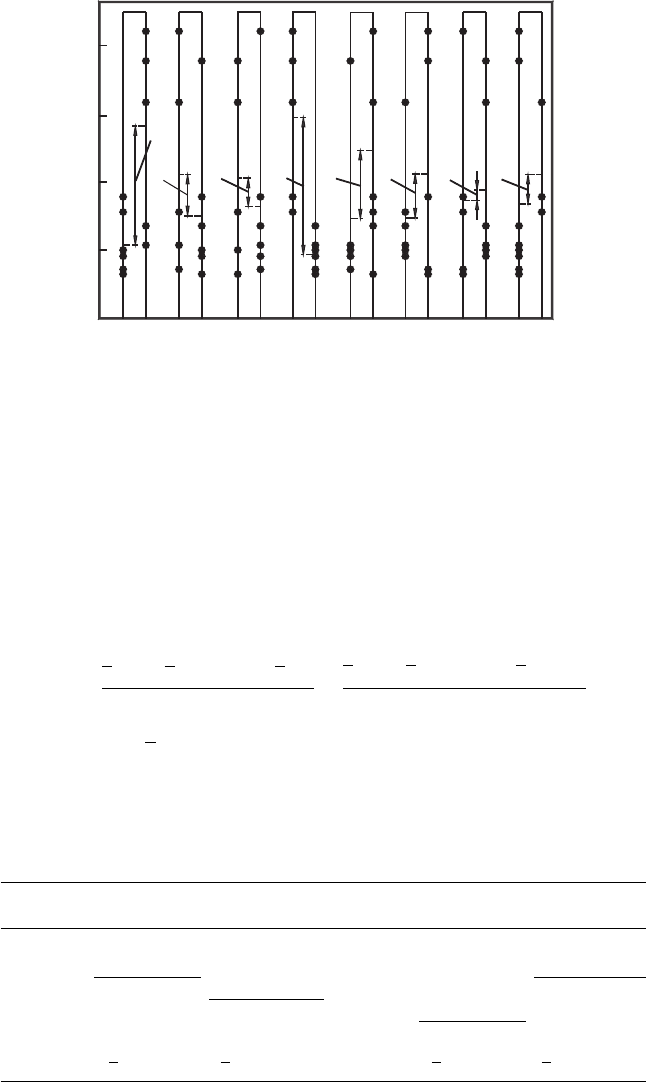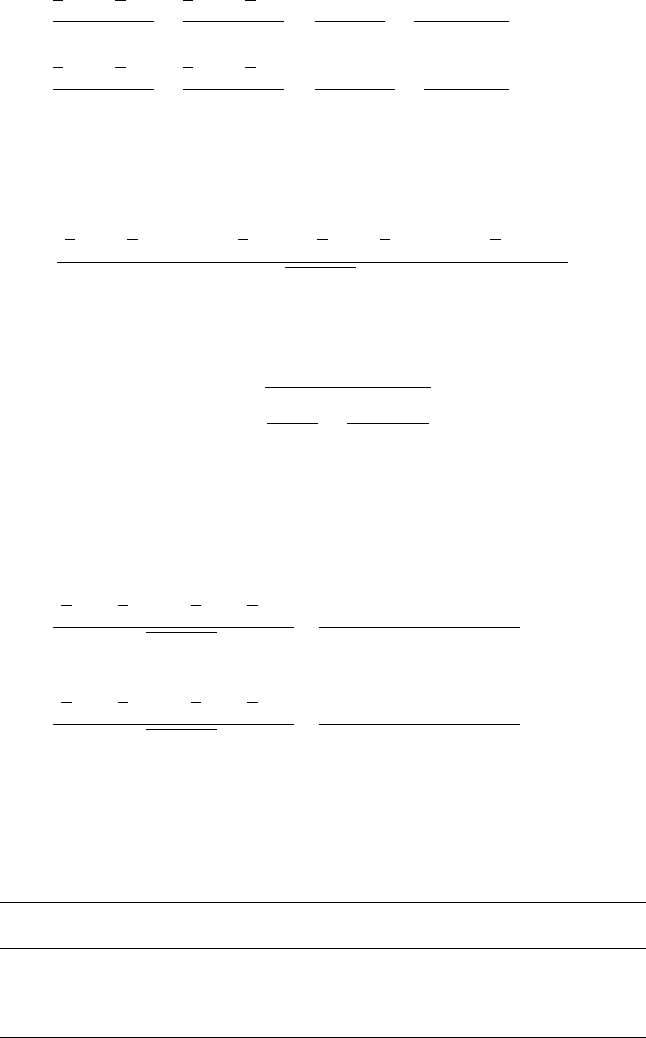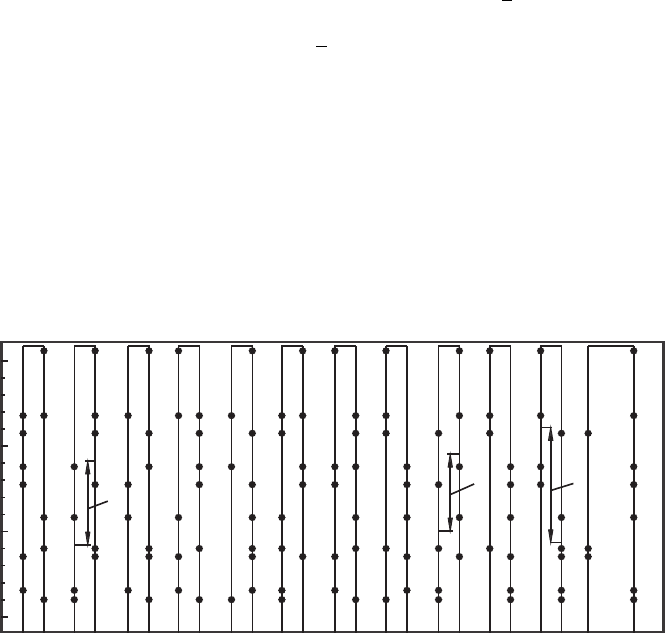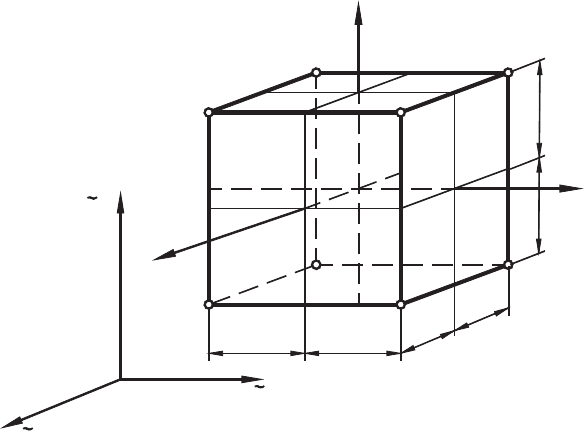Astakhov V. Tribology of Metal Cutting
Подождите немного. Документ загружается.


Design of Experiments in Metal Cutting Tests 287
a flow rate up to 75 l/min and generating a pressure of 12 MPa. The stationary
workpiece-rotating tool working method was used in the tests. The feed motion was
applied to the gundrill.
Work material – hot rolled medium carbon steel AISI 1040 was used. The actual chemi-
cal composition has been analyzed using a LECO SA-2000 Discharge-Optical Emission
Spectrometer. Special metallurgical parameters such as the element counts, microstruc-
ture, grain size, inclusions count, etc, were determined using quantitative metallography.
The test bars, after being cut to length (40 mm diameter, 700 mm length), were normalized
to a hardness of HB 200.
Gundrills – gundrills of 12.1 mm diameter were used. The material of their tips was
carbide M 30. The parameters of drill geometry were kept within a close tolerance of
±0.2
◦
. The surface roughness R
a
of the rake and flank faces did not exceed 0.25 µm.
Each gundrill used in the tests was examined at a magnification of ×25 for visual defects
such as chipping, burns and microcracks. When resharpening, the tips were ground back
at least 2 mm beyond the wear marks.
Cutting fluid (coolant) – “Shell Garia H” cutting fluid was used in the tests. Its
temperature was maintained at 27 ±3
◦
C and its purity at 10 µm.
Cutting conditions – the optimal cutting speed – 110 m/min (2894 rpm), and feed rate –
90 mm/min were selected using the results of a calibration test for given work and tool
materials. The principles of the first metal cutting law (discussed in Chapter 4) were used
to determine the optimal cutting temperature.
Tool life criteria – the average width of the flank wear land VB
B
=0.4 mm was selected as
the prime criterion and was measured in the tool cutting edge plane containing the cutting
edge and the directional vector of prime motion. However, excessive tool vibration
and/or squeal were also used in some extreme cases.
Eight factors have been selected for this sieve DOE and their intervals of variation are
shown in Table 5.1.
Table 5.1. The level of the factors selected for the sieve DOE.
Factors Approach
angle
(ϕ
1
)(
◦
)
Approach
angle
(ϕ
2
)(
◦
)
Flank
angle
(α
n1
)
(
◦
)
Drill point
offset (m
d
)
(mm)
Flank
angle
(α
n2
)
(
◦
)
Shoulder
dub-off
angle(ϕ
4
)
(
◦
)
Rake
angle
(γ)
(
◦
)
Shoulder
dub-off
location
(b) (mm)
Code
designation
x
1
x
2
x
3
x
4
x
5
x
6
x
7
x
8
Upper level
(+)
45 25 25 3.0 12 45 5 4
Lower level
(−)
25 10 8 1.5 7 20 0 1

288 Tribology of Metal Cutting
Table 5.2. Design matrix.
Experiment
number
Factors Tool life (min)
x
1
x
2
x
3
x
4
x
5
x
6
x
7
x
8
y
1
y
2
y
3
1 ++−−+−+− 7 18.75 11.11
2 +++−−++−16 11.50 11.50
3 −+−−++−+11 11.00 11.00
4 −−+++−−+38 21.75 16.61
5 +−−+−−+−18 13.50 13.50
6 +−+−++−−10 21.75 14.61
7 −−−−−+−+14 14.00 14.00
8 −+−+−−++42 25.75 16.61
9 +−−−−+−+ 9 20.75 20.75
10 −+++−+−−32 15.75 15.75
11 +−+−−−+− 6 17.75 10.61
The design matrix was constructed as follows: all the selected factors were separated
into two groups. The first one contained factors x
1
,x
2
,x
3
,x
4
, form a half-replica
2
4−1
with the defining relation I = x
1
x
2
x
3
x
4
. In this half-replica, the effects of
the factors and the effects of their interactions are not mixed. The second half-
replica was constructed using the same criteria. A design matrix was constructed
using the first half-replica of the complete matrix and adding to each row of this
replica a randomly selected row from the second half-replica. Three more rows
were added to this matrix to assure proper mixing and these rows were randomly
selected from the first and second half-replicas. Table 5.2 shows the design matrix
constructed.
As soon as the design matrix is completed, its suitability should be examined using
two simple rules. First, a design matrix is suitable if it does not contain two identical
columns having the same or alternate signs. Second, a design matrix should not contain
columns whose scalar products with any other column result in a column of the same
(“+”or“−”) signs. The design matrix shown in Table 5.2 was found suitable as it meets
the requirements set by these rules.
The test results are shown in column
y
1
as the average tool life calculated over three
independent tests under the test conditions indicated.
5.3.5 Analysis
Analysis of the results of sieve DOE begins with the construction of a correlation (scatter)
diagram shown in Fig. 5.3. Its structure is self-evident. Each factor is represented by a
vertical bar having on its left side, values (as dots) of the response obtained when this
factor was positive (the upper value) while the values of the response corresponding to
lower level of the factor considered (i.e. when this factor is negative) are represented
by dots on the right side of the bar. As such, the scale makes sense only along the
vertical axis.

Design of Experiments in Metal Cutting Tests 289
40
30
20
10
+−
x
1
x
2
+−
x
3
+−
x
4
+−
x
5
+−
x
6
+−
x
7
+−
x
8
+−
x
16.4
5.77
3.57 19.7 10.6 6.9
1.2
4.9
y
Fig. 5.3. Correlation diagram (first sieve).
Each factor included in the experiment is estimated independently. The simplest way to
do this is to calculate the distance between the means on the left and right sides of each
bar. These distances are shown on the correlation diagram in Fig. 5.3. As shown, these are
the greatest for factors x
1
and x
4
and thus these two factors are selected for the analysis.
The effects of factors are calculated using special correlation tables. A correlation table
(Table 5.3) was constructed to analyze the two factors considered. Using the correlation
table, the effect of each selected factor can be estimated as
X
j
=
y
1−1
+y
1−3
+···+y
1−n
m
−
y
1−2
+y
1−4
+···+y
1−(n−1)
m
, (5.9)
where m is number of
ys for the factor considered assigned to the same sign (“+”or“−”).
It follows from Table 5.3 that m = 2.
Table 5.3. Correlation table (first sieve).
Estimated
factor
+x
1
−x
1
Estimated
factor
+x
1
−x
1
16 38 7 11
18 42 10 14
32 9
+x
4
+x
4
11
$
y
1−1
= 34
$
y
1−2
= 112
$
y
1−3
= 37
$
y
1−4
= 25
y
1−1
= 17 y
1−2
= 37.3 y
1−3
= 9.3 y
1−4
= 12.5

290 Tribology of Metal Cutting
The effects of the selected factors were estimated using data in Table 5.3 and Eq. (5.10) as
X
1
=
y
1−1
+y
1−3
2
−
y
1−2
+y
1−4
2
=
17 + 9.3
2
−
37.3 + 12.5
2
=−11.75 (5.10)
X
4
=
y
1−1
+y
1−2
2
−
y
1−3
+y
1−4
2
=
17 + 37.3
2
−
9.3 + 12.5
2
= 16.25 (5.11)
The significance of the selected factors is examined using the Student’s t-criterion,
calculated as
t =
y
1−1
+y
1−3
+···+y
1−n
−
y
1−2
+y
1−4
+···+y
1−(n−1)
$
i
s
2
i
/n
i
, (5.12)
where s
i
is the standard deviation of ith cell of the correlation table defined as
s
i
=
"
$
i
y
2
i
n
i
−1
−
$
i
y
i
2
n
i
(
n
i
−1
)
, (5.13)
where n
i
is the number of terms in the cell considered.
The Student’s criteria for the selected factors are calculated using the results presented
in the auxiliary table (Table 5.4) as follows:
t
X
1
=
y
1−1
+y
1−3
−
y
1−2
+y
1−4
$
i
s
2
i
/n
i
=
(17+9.3)−(37.3+12.5)
3.52
=−6.68 (5.14)
t
X
4
=
y
1−1
+y
1−2
−
y
1−3
+y
1−4
$
i
s
2
i
/n
i
=
(17+37.3)−(9.3+12.5)
3.52
=9.23 (5.15)
Table 5.4. Calculating t-criterion.
Cell number
$
y
1−i
$
y
1−i
2
$
y
2
1−i
n
i
s
2
s
2
/n
i
1 34 1156 580 2 2.00 1.00
2 112 12544 4232 3 25.33 8.44
3 37 1369 351 4 2.92 0.73
4 25 625 317 2 4.50 2.25

Design of Experiments in Metal Cutting Tests 291
A factor is considered to be significant if t
x
>t
cr
, where the critical value, t
cr
for the
Student’s criterion is found in a statistical table for the following number of degrees of
freedom
f
r
=
#
i
n
i
−k =11−4=7, (5.16)
where k is the number of cells in the correlation table.
For the case considered, t
99.9
= 5.959 (Table 5.7 in [16]) so that the factors considered
are significant with a 99.9% confidence level.
The procedure discussed is the first stage in the proposed sieve DOE and thus it is
referred to as the first sieve. This first sieve allows the detection of the strongest factors,
i.e. those factors that have the strongest influence on the response. After these strong
linear effects are detected, the size of “the screen” to be used in the consecutive sieves
is reduced to distinguish less strong effects and their interactions. This is accomplished
by the correction of the experimental results presented in column
y
1
of Table 5.2. Such
a correction is carried out by adding the effects (with the reverse signs) of the selected
factors (Eqs. (5.11) and (5.12)) to column
y
1
of Table 5.2, namely, by adding 11.75 to
all the results at level “+x
1
” and −16.25 to all the results at level “+x
4
.” The corrected
results are shown in column y
2
of Table 5.2. Using the data from this table, one can
construct a new correlation diagram shown in Fig. 5.4, where, for simplicity, only a few
interactions are shown although all possible interactions have been analyzed. Using the
approach described above, a correlation table (second sieve) was constructed (Table 5.5)
and the interaction x
4
x
8
was found to be significant. Its effect is X
48
=7.14.
After the second sieve, column y
3
was corrected by adding the effect of X
48
with the
opposite sign, i.e. −7.14 to all the results at level +x
48
. The results are shown in
x
5
x
4
x
3
x
1
x
2
+− +− +− +− +− +− +− +− +− +− +− + −
10
x
7
x
8
x
6
15
20
y
25
5.07
x
3
x
7
x
1
x
6
4.54
x
4
x
8
x
2
x
3
x
5
x
6.82
Fig. 5.4. Correlation diagram (second sieve).

292 Tribology of Metal Cutting
Table 5.5. Correlation table (second sieve).
Estimated factor +x
3
x
7
−x
3
x
7
+x
4
x
8
−x
4
x
8
+x
2
11.5 18.75 18.75 11.5
11 25.75 25.75 11
15.75 15.75
$
y
2−1
=22.5
$
y
2−2
=60.25
$
y
2−3
=44.5
$
y
2−4
=38.25
y
2−1
=11.25 y
2−2
=20.08 y
2−3
=22.25 y
2−4
=12.75
Estimated factor + x
3
x
7
−x
3
x
7
+x
4
x
8
−x
4
x
8
14 21.75 21.75 13.50
20.75 13.5 21.75 14
−x
2
17.75 21.75 17.75 20.75
$
y
2−5
=52.5
$
y
2−6
=57
$
y
2−7
=61.25
$
y
2−8
=48.25
y
2−5
=17.5 y
2−6
=19 y
2−7
=20.42 y
2−8
=16.08
column y
3
of Table 5.2. Normally, the sieve of the experimental results continues while
all the remaining effects and their interactions become insignificant, at say a 5% level
of significance if the responses were measured with high accuracy and a 10% level if
not. In the case considered, the sieve was ended after the third stage because the analysis
of these results showed that there are no more significant factors or interactions left.
Figure 5.5 shows the scatter diagram of the test discussed. As shown in the figure, the
scatter of the analyzed data reduces significantly after each sieve, so normally three
sieves are sufficient to complete the analysis.
10
y
1
20
30
40
y
2
y
3
Tool life, min
Fig. 5.5. Scatter diagram.

Design of Experiments in Metal Cutting Tests 293
Table 5.6. Summary of the sieve test.
Stage of sieve Distinguished factor Effect t-Criterion
Original data x
1
−11.5 6.68
x
4
16.25 9.23
First sieve x
48
7.14 4.6
Second sieve – – –
The results of the proposed test are summarized in Table 5.6. Figure 5.6 shows the
significance of the effects distinguished in terms of their influence on tool life. As shown,
two linear effects and one interaction having the strongest effects were distinguished. The
negative sign of x
1
shows that tool life decreases when this parameter increases. The
strongest influence on tool life has the drill point offset m
d
.
While the linear effects distinguished are known to have strong influence on tool life, the
interaction x
4
x
8
distinguished has never before been considered in any known studies on
gundrilling.
5.3.6 Concluding remarks
The proposed sieve DOE allows experimentalists to take into consideration as many
factors as needed. Conducting a relatively simple sieve test, the significant factors and
their interactions can be distinguished objectively and then used in the subsequent full
DOE. Such an approach allows one to reduce the total number of tests dramatically
without losing any significant factor or factor interaction. Moreover, interactions of any
order can be easily analyzed. The proposed correlation diagrams make such an analysis
simple and self-evident.
x
4
x
4
x
8
x
1
x
5
x
6
x
2
etc.
−
0
6
12
18
Effect
Fig. 5.6. Significance of the effects distinguished by the sieve DOE (Pareto analysis).
294 Tribology of Metal Cutting
Three factors are found to have a significant effect on tool life in gundrilling. As was
expected, the strongest influence has the drill point offset m
d
. It was also found that tool
life decreases when the approach angle of the outer cutting edge increases.
The interaction x
4
x
8
distinguished has never before been considered in the known
analyses on tool life in gundrilling. Using this factor and results of the complete
DOE, a new geometry of gundrills has been developed.
5.4 2
k
Factorial Experiment, Complete Block
This type of experiments are utilized to investigate the effects of one or more factors
on the response. When an experiment involves more than one factor, these factors can
influence the response individually as well as jointly. In the case of one factor-at-a time
experiment, the selected experimental methodology does not allow proper assessment of
the joint effects of the factors involved.
Factorial experiments conducted in completely randomized designs are especially useful
for evaluating the joint factor effects. Factorial experiments include all possible factor
combinations in the experimental design. Completely randomized designs are appropriate
when there are no restrictions on the order of testing.
The mathematical description of the object under study in the vicinity of zero point can
be obtained by varying each factor at two levels distinguished from the zero level by
the interval of variation. When the experiment includes all possible non-repeated factor-
level combinations, it is called as the complete block. The number of such combinations
is N = 2
k
.
5.4.1 Regression model and design matrix
Consider the case where three factors are taken into consideration. As such we deal with
2
3
factorial experiment that demonstrated its usefulness in metal cutting tests [3,9]. The
regression equation for this test is
y =E
%
y
&
=b
0
+
3
#
i=1
b
i
˜x
i
+
3
#
i,j=1
b
ij
˜x
i
˜x
j
+b
123
˜x
1
˜x
2
˜x
3
(5.17)
The complete block enables one to obtain the separate (non-mixed) estimates for all
coefficients b of this model. This is the major advantage of this type of DOE.
Obtaining the mathematical model in the form of Eq. (5.18) includes the following stages:
• Design of experiment: statement of the problem; selection of the response and fac-
tors to be involved; determining the levels of the factors, selection of the sequence
of the factor-level combinations – construction of the design matrix; selection

Design of Experiments in Metal Cutting Tests 295
Table 5.7. Treatment combinations and effects in 2
3
factorial experiment.
Point of matrix (u) x
0
x
1
x
2
x
3
x
1
x
2
x
1
x
3
x
2
x
3
x
1
x
2
x
3
1 +−−− + + + −
2 ++−− − − + +
3 +−+− − + − +
4 +++− + − − −
5 +−−+ + − − +
6 ++−+ − + − −
7 +−++ − − + −
8 ++++ + + + +
of the number of observations to be taken at each point of the design matrix; selection
of a regression model to describe the experimental results.
• Experiment itself as a series of tests; data collection in each test.
• Evaluation and analysis: examination of the statistical significance of the model
coefficients; examination of the homogeneity of the row variances; examination of
the adequateness of the mathematical model obtained.
Using the code values (+1, −1), the experimental conditions can be written as the design
matrix, where the rows correspond to different tests and the columns correspond to the
different code values of the factors [2]. The design matrix for a 2
3
factorial experiment
(complete block) is shown in Table 5.7. In this table, columns x
1
, x
2
and x
3
form the
design matrix because they directly set up the test conditions. Further to the right, the
columns for interactions x
1
x
2
, x
1
x
3
, x
2
x
3
and x
1
x
2
x
3
are placed. These are to be used
for the estimation of the factor interactions. A pseudo-variable x
0
is also added for the
estimation of coefficient b
0
. The value of x
0
(+1) is the same in all rows.
The design matrix described can be represented graphically, as shown in Fig. 5.7. New
coordinate axes x
1
, x
2
, x
3
are drawn through the origin 0 parallel to the original axes of
the factors. The origin 0 corresponds to the basic (zero) level of the factors. The scale
of the new coordinate system is selected so that the intervals of variation of each factor
are equal to 1. Therefore, the design is a cube with the eight runs forming the corners of
the cube, as shown in Fig. 5.7.
The following notation of tests is normally used. A number u (u =1,2,..., 8) is attributed
to each point in the design matrix. The tests have double numbering, the first number
shows the point in the design matrix; the second is a number of the repetition in this
point. The number of repetitions at the same point is designated by r
u
(r
u
> 1). For
example, y
23
is the response obtained in the third test conducted at the second point of
the design matrix.
5.4.2 Properties of 2
k
factorial experiment, complete block
There are several important properties of a complete block design matrix making this
matrix very suitable for obtaining the mathematical models using the experimental data.

296 Tribology of Metal Cutting
x
1
4
5
6
7
8
+1
1
2
3
−1
−1
−1 +1
+1
x
2
x
3
x
1
x
2
x
3
0
Fig. 5.7. Graphical representation of the 2
k
design.
First two directly stem from the way the matrix is constructed. The first property is the
matrix symmetry relative to the center of the experiment. It can be described as follows:
the sum of elements of each vector-column (except that for x
0
) is equal to zero, i.e.
m
#
u=1
x
iu
=0,i=1,2,...,2
k
−1, (5.18)
where u, m are the number of a point and the total number of points in the matrix,
respectively.
The second property is that the sum of squares of the element of each vector-column is
equal to the number of the points in the matrix, i.e.
m
#
u=1
x
2
iu
=m, i =1,2,...,2
k
−1 (5.19)
The third property is called the orthogonality of the design matrix. Orthogonality in such
a context means that the sum of the product of entries of any two vector-columns in the
matrix is equal to zero, i.e.
m
#
u=1
x
iu
x
ju
=0,i=j, i, j =1,2,...,2
k
−1 (5.20)
